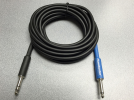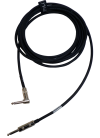You might wish to check your definition of "balanced" regards TS. Unless this is something entirely new and unheard of before, "balanced" usually means XLR or TRS.
Balanced requires two conductors and a shield, so XLR or TRS fit the bill.
A TS can't be balanced. A Humbuster cable isn't balanced, but it's playing a trick using a special circuit and the three conductor cable to sense noise being picked up by the wiring. The signal travels the cable from the ring, then returns to the modeler from the TS end via the shield to the circuit in the modeler which cancels the noise, so effectively the entire length of the cable is being monitored. What happens once the audio signal gets to the far end is up to that unit, but it won't be seeing a balanced signal.
The problem is that the BTPA.com page does not describe beyond saying that the cable is humbuster.
There's nothing else that really needs to be said, since "Humbuster" specifies how the cable is wired. BTW, BTPA is a member of the forum so feel free to ask them directly.
As far as popping, I think it's partly dependent on the speakers and how they get their amplified signal. Some are smart and monitor the connection and drop their volume when they see no signal; I had some studio monitors years ago that did that nicely. A power-amp connected to a guitar cab or unpowered speakers is less likely to have that sort of circuit so pops are more likely to happen.
When I've been in the situation where I had to restart the modeler I immediately told FOH who turned off my feed, then I turned off my monitor, rebooted, powered on the monitor and FOH brought it back up when they saw I was ready.
We have to know our equipment but "merde" can happen on stage, and it's good to think about how to react to it before it does. I've seen many times when a pro-act had a technical failure on stage, and someone in the band started talking to the audience, explained there was a problem that they're working on, kept the audience engaged until it was fixed, then they restarted the song. That's an important part of being on stage, don't freak out, get it solved and keep the audience happy.
PS - All three unit's manuals state the modelers have pop-suppression, but also caution that it's still good to turn down or mute connected devices when powering on/off. For instance, from the FM9 manual:
The power receptacle has an integrated Power Switch which turns the power on or off. The FM9 features pop suppression, but it is still advisable to turn down or mute connected devices when powering on or off.


